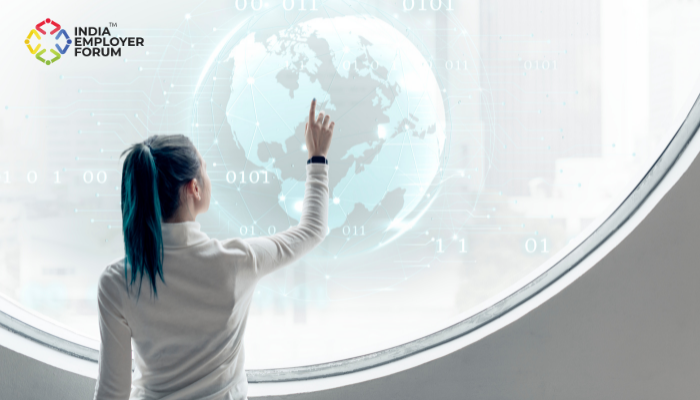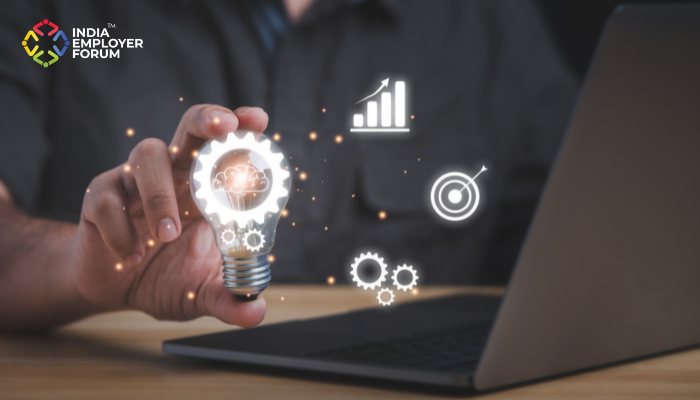In the wake of technological revolution, Artificial Intelligence (AI) has been growing in popularity. It has and will continue to shape the way we live, act, work, and follow ethical aspects of the society. The human workforce counterpart has been under tremendous stress as AI is being observed as the future of work and there is a threat for mass lay-offs as AI is equipped to handle many of the mundane task-oriented jobs. It is high time we looked at the strengths and disadvantages of such an AI-led workforce and determined a route to strengthen AI and human collaboration.
To make peace with AI and human collaboration as the future of work, we have to first understand how AI would come in handy in many scenarios, such as helping us solve complex problems, improving decision-making processes, and increasing productivity across various industries. From healthcare to finance to even politics, AI has the potential to transform the future of work, by being more efficient and effective. AI can help us tackle some of the world’s biggest challenges, like climate change and disease prevention, by helping us to process large amounts of data to identify patterns that humans alone may not be able to detect in a short span of time.
You might also be interested to read: The New Age Of Artificial Intelligence In HR
To understand that the future of work lies in the peace between AI and human collaboration, we now need to know the limitations of AI, where the human workforce comes in with force. AI can enhance human capabilities but it definitely cannot serve as a replacement for human intelligence as well as human judgement. AI is good at receiving data and providing an output. But when it comes to matters of ethics, empathy, creativity, etc. humans are irreplaceable.
We can clearly understand that the future of work needs involvement of both AI and human collaboration. Let us meditate on how to make this possible for the HR Industry to take care of.
- Augmented Intelligence: This is crucial because AI invests in making reports and data as fed by the human counterpart and giving solutions, but the human beings have the final say in which route to take. For example, in the medical field, AI can help with the analysis of patient data and potential health risks, but the doctors, which is the part of human collaboration, will take the final call about the diagnosis and treatment plans. We observe how AI is rather a supplement to human workforce and not a replacement, and this is how the future of work looks like for the benefit of all parties involved.
- Human-in-the-loop systems: This system ascertains that AI is necessary for the processing of data, but human collaboration is also important to make decisions and to oversee ethical questions. For example, in AI-driven cars, automation takes over the steering and functioning of the vehicle, but a human is needed to oversee the functioning and to take over during emergencies, which the AI cannot do in an informed manner. This is, again, how the future of work looks like.
- Cobots: Cobots are practically collaborative robots. Cobots are designed in such a manner with safety ensured tactics that they are safe to work alongside and in collaboration with the human workforce. The cobots and humans share a workspace which is common to them. The human workforce is free to do the complex work while the cobots can easily take care of repetitive jobs. Cobots are also designed to take up the dangerous work which otherwise might hamper the health of the human workforce.
- Explainable AI: Here the AI is responsible for creating the rationale and reasoning behind its AI generated reports and decisions, which provide a link of trust between AI and the human workforce, which enables the future of work to look healthy. It is important for specialisations like medicine and finance, where the impact of human lives are at stake, and a joint decision of AI and human workforce is preferrable.
We have observed how AI and human collaboration is the future of work, globally, in almost every field. There are a few parameters like transparency and privacy to ensure that AI is developed and deployed in a responsible and ethical manner through the use of guidelines in place in the industries. Transparency could be about organisations being transparent about the use of AI and the data that is being used to train the AI systems. It helps in building trust between humans and AI to ensure that decisions made by AI are ethical and responsible as per the human standards. Privacy, on the other hand, could be about maintaining the privacy of individuals whose data is being processed and the data could contain sensitive information regarding the individual.
Conclusion: With AI enabling help in many facets of organisations and industries, the human workforce is getting a lot of insight—and fast insight into various phenomena. AI can never replace human intelligence and ethics, which is why it is paramount to combine both these boons and streamline work in such a way that it is beneficial for all across the globe. The future of work relies on the combination of AI and human collaboration, and it is high time we made peace with this piece of fact.
References:
- Strengthening AI and human collaboration to thrive in the future of work: Sarah Eryan, HR Director – Middle East & Africa, Fragomen, Economic Times, February 24 (2023)
- How Do We Build Trust Between Humans and AI, WeForum.Org, August 1 (2019)
- Wikipedia: Human-in-the-loop
You might also be interested to read: 6 Trends that will Change the HR Industry in 2023




